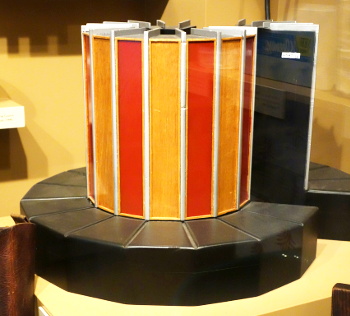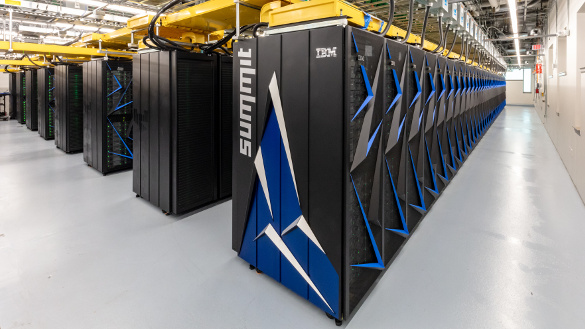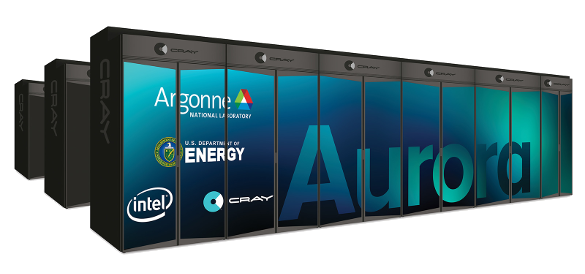Aurora Exascale Computer
June 10, 2019
During the first
decades of
electronic computers that began in earnest with the construction of
ENIAC in 1945, all computing was done on room-filling
mainframe computers. While these proved useful for tasks such as printing
paychecks and facilitating the
census,
scientists and
engineers needed faster computers. Thus arose a different kind of computer called the
supercomputer.
An important milestone in supercomputer design was the
Cray-1, named for its talented designer,
Seymour Cray (1925-1996), who is known as the father of supercomputing. The Cray supercomputer's
innovation was in its implementation of
vector processing, which was a huge advance over the
scalar processing motif of the mainframes. The first Cray-1 was delivered to
Los Alamos National Laboratory in 1976.
Integrated circuit technology was not very advanced at the time of the Cray's introduction, There were not many
transistors per
chip, the transistors were
bipolar, not
field effect, and high-speed
circuitry generated quite a bit of
heat. For that reason,
liquid cooling using
Freon was required for its
power-hungry ECL logic chips. The Cray-1
floating point performance was about 80 million
floating-point operations per second (FLOP).[1] The supercomputers of today are in the hundreds of
petaflop range, which is a million times faster.

Cray-1 supercomputer at the Wisconsin Historical Museum, Madison, Wisconsin.
As an illustration of how technology has progressed, a typical smartphone is about ten times faster and nearly 30,000 times lighter than the Cary-1.
(Wikimedia Commons image by Daderot.)
The above
photograph shows the unusual
shape of the Cray-1. This shape wasn't dictated by
aesthetics alone. The
speed of light is such that it takes 3.3
nsec for light to travel one
meter.
Electrical signals in
wire travel about a meter in 5 nsec. Converting
time to
frequency shows that electrical signals can only traverse a meter at a rate of 200
MHz. The
clock rate of the Cary-1 was 80 MHz.
At about the same time that the Cray-1 was introduced, the
pre-Internet meme for a more powerful supercomputer was the "
hairy,
smoking,
golf ball." Golf ball indicates the small size needed because of the limitation imposed by the speed of light, while hairy indicates all the wires needed to
exchange data with the outside world, and a
128-bit data word would require 128 wires plus a
signal return. Indeed, the
ball grid array interconnects of today's complex integrated circuits are equivalent of having nearly 500 wires. This computer would be smoking, since the
power dissipation of the
silicon circuitry used at that time was about two
watts per
square inch, and a lot of silicon would be needed inside the golf ball.
Integrated circuit technology has improved over the decades, so modern supercomputers never entered a hairy, smoking golf ball phase. The earliest useful
microprocessor, the
Intel 8080, had
4,500 transistors based on 6,000
nm lithography. Today's
32-core AMD Epyc processor has nearly 20 billion transistors that are rendered by a 14 nm lithographic process onto a 768
mm2 die.

The Summit supercomputer at Oak Ridge National Laboratory (ORNL, Oak Ridge, Tennessee). This supercomputer presently holds first place on the top500.org list of supercomputers. (Oak Ridge National Laboratory image)
There's a
website,
top500.org, that keeps track of the world's fastest computers. Here's a list of the top five as of this writing:
#1 Summit, a supercomputer at
Oak Ridge National Laboratory (ORNL, Oak Ridge, Tennessee), has a performance of 143.5
petaflop/second on a
software benchmark written in the
HPL language. Summit is built from 4,356 computing
nodes incorporating
GPUs communicating via
InfiniBand.
#2 Sierra, a supercomputer at
Lawrence Livermore National Laboratory
(Livermore, California) has an
architecture very similar to Summit. It's built with 4,320 nodes to achieve 94.6 petaflop/second.
#3 Sunway TaihuLight is a supercomputer developed by
China's National Research Center of Parallel Computer Engineering & Technology (NRCPC, Wuxi, China). It has a performance of 93 petaflop/second, quite close to that of #2 Sierra.
#4 Tianhe-2A (Milky Way-2A) is a supercomputer developed by China's
National University of Defense Technology (NUDT, Changsha, China) with a performance of 61.4 petaflop/second.
#5 Piz Daint, a
Cray XC50 system with 361,760-
cores installed at the
Swiss National Supercomputing Centre (CSCS, Lugano, Switzerland) has a performance of 21.2 petaflop/second. Note the large gap between this supercomputer and the next highest on the list.
We're at the point in computational performance at which the
metric prefix beyond
peta- (10
15) will be breached. The next step is
exa- (10
18) and
exascale computing with 10
18 floating point operations per second. The push towards exascale computing in the
United States began in July, 2015, with the creation of a
National Strategic Computing Initiative. In March, 2019, the
United States Department of Energy announced that the first exaFLOP supercomputer, called Aurora, a joint development of
Argonne National Laboratory (Argonne, Illinois),
Intel and Cray, would be operational at Argonne by the end of 2021.[2-4]
Aurora, which will be sited at the
Argonne Leadership Computing Facility that was established in 2006, will be constructed at a cost of more than $500 million.[2-4] Says
United States Secretary of Energy,
Rick Perry,
"Achieving exascale is imperative, not only to better the scientific community, but also to better the lives of everyday Americans... Aurora and the next generation of exascale supercomputers will apply HPC and AI technologies to areas such as cancer research, climate modeling and veterans' health treatments. The innovative advancements that will be made with exascale will have an incredibly significant impact on our society."[2]
Aurora will include several technological innovations, such as a new I/O system, the Distributed Asynchronous Object Store (DAOS), a future generation of Intel's
Xeon architecture, and Cray's next-generation Shasta platform contained in 200
cabinets. Aurora is designed specifically to open high-performance computing to
artificial intelligence applications.[2,4] It's expected that Aurora will be used to investigate questions in
physical cosmology,
alternative energy sources, the design safer
vehicles, the
invention of new
materials, and
neuroscience.[3]

The proposed Aurora supercomputer that will be sited at the Argonne Leadership Computing Facility of Argonne National Laboratory. (Argonne National Laboratory image.)
To these ends, the DOE has established the
Aurora Early Science Program of 15 projects whose project teams will
collaborate with
computer scientists in
code migration and
optimization for the Aurora.[3] Some of these projects are listed below:[3]
· Extreme-Scale Cosmological Hydrodynamics, Katrin Heitmann, Principal Investigator.
· Exascale Computational Catalysis, David Bross, Principal Investigator.
· Dark Sky Mining, Salman Habib, Principal Investigator.
· Enabling Connectomics at Exascale to Facilitate Discoveries in Neuroscience, Nicola Ferrier, Principal Investigator.
References:
- Neal Pritchett, "Mini Cray," notpurfect.com.
- U.S. Department of Energy and Intel to deliver first exascale supercomputer, Argonne National Laboratory Press Release, March 18, 2019.
- Aurora - Coming in 2021, Argonne National Laboratory Website.
- Stephen Mraz, "Intel and Cray Will Deliver First Exoscale Supercomputer to National Lab, Electronic Design, April 24, 2019.
- Aurora: Argonne’s Next-Generation Exascale Supercomputer, YouTube Video by Argonne National Laboratory, March 19, 2019.
- Cray Announces First Exascale System, YouTube Video by Cray Inc., March 18, 2019.
Linked Keywords: Decade; electronic; computer; ENIAC; mainframe computer; paycheck; census; scientist; engineer; supercomputer; Cray-1; Seymour Cray (1925-1996); innovation; vector processing; >scalar processing; motif (narrative); Los Alamos National Laboratory; integrated circuit; technology; transistor; chip; bipolar junction transistor; field-effect transistor; electronic circuit; heat; server immersion cooling; liquid cooling; chlorofluorocarbon; Freon; energy conversion efficiency; power-hungry; emitter-coupled logic; ECL logic chip; floating-point arithmetic; FLOPS; floating-point operations per second; petaflop; Cray-1; supercomputer; Wisconsin Historical Museum; Madison, Wisconsin; smartphone; Daderot; photograph; geometry; shape; aesthetics; speed of light; nanosecond; nsec; meter; electrical signal; wire; time; frequency; hertz; MHz; clock rate; Internet meme; hair; hairy; smoke; smoking; golf ball; input/output; I/O; data exchange; 128-bit; word (computer architecture); ground (electricity); signal return; ball grid array interconnect; electric power; dissipation; silicon; watt; square inch; microprocessor; Intel 8080; 4,500 transistors; nanometer; nm; photolithography; 32-core AMD Epyc processor; millimeter; mm; Summit (supercomputer); supercomputer; Oak Ridge National Laboratory (ORNL, Oak Ridge, Tennessee); top500.org; website; petaflop/second; benchmark (computing); software benchmark; LINPACK benchmark; HPL language; node (networking); graphics processing unit; GPU; communication; InfiniBand; Sierra (supercomputer); Lawrence Livermore National Laboratory; systems architecture; Sunway TaihuLight; China; National Research Center of Parallel Computer Engineering & Technology (NRCPC, Wuxi, China); Tianhe-2A (Milky Way-2A); National University of Defense Technology (NUDT, Changsha, China); Piz Daint (supercomputer); Cray XC50; multi-core processor; core; Swiss National Supercomputing Centre (CSCS, Lugano, Switzerland); metric prefix; peta-; exa-; exascale computing; United States; National Strategic Computing Initiative; United States Department of Energy; Argonne National Laboratory (Argonne, Illinois); Intel; Argonne Leadership Computing Facility; United States Secretary of Energy; Rick Perry; American; HPC; Artificial intelligence; AI; cancer; climate model; veteran; health care; society; Xeon; 19-inch rack; cabinet; physical cosmology; alternative energy; motor vehicle; invention; material; neuroscience; Argonne Leadership Computing Facility; Aurora Early Science Program; collaboration; collaborate; computer scientist; system migration; code migration; optimizing compiler; code optimization; smoothed-particle hydrodynamics; Cosmological Hydrodynamics; Katrin Heitmann; Principal Investigator; computational chemistry; Catalysis; David Bross; observational astronomy; Dark Sky; data mining; Salman Habib; Connectomics; Nicola Ferrier.